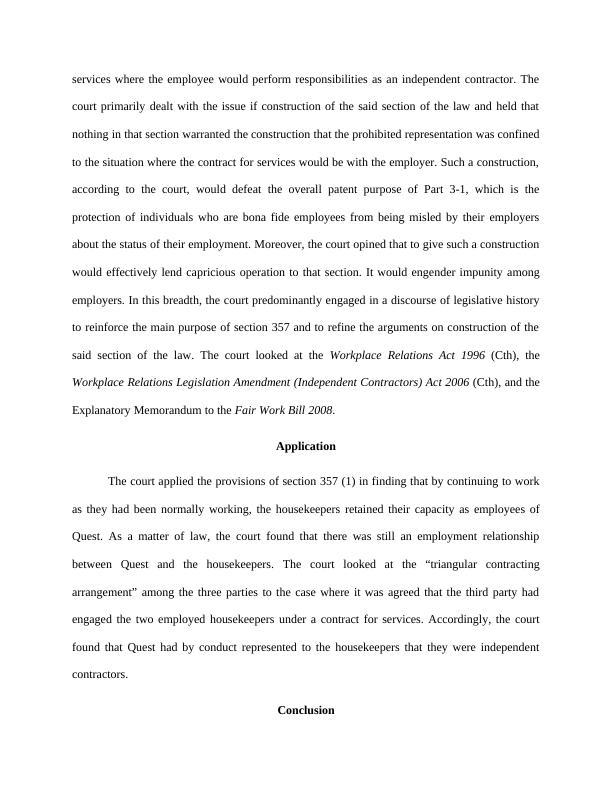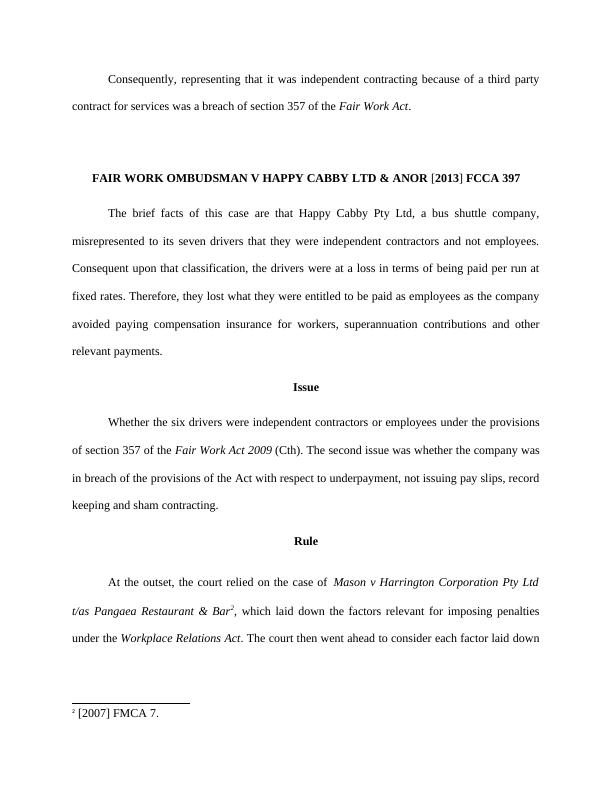(PDF) Teaching Law to Non-law Students
Added on 2021-05-30
14 Pages2610 Words95 Views
THE ‘IRAC’ APPROACH TO ANSWERING LAW PROBLEMSName Course Date

IntroductionThis paper reviews four decisions of the court that relate to workplace law with the aimof deconstructing them in light of the issues, rule applied, application of the rules and theconclusion. The aim of this article is to employ the IRAC method of answering legal problems insummerising the cases. Ultimately, this paper identifies the issues in the cases, the rules of lawapplied, how the courts applied the rules to the facts of the case and the conclusion or holdings ofthe courts. FAIR WORK OMBUDSMAN V QUEST SOUTH PERTH HOLDINGS PTY LTD [2015]HCA 45The brief facts of the case were that Quest encouraged two employed housekeepers tobecome independent contractors for the purpose of being engaged for third party work. IssueThe main issue for determination was whether Quest South Perth Holdings Pty Ltd(hereinafter referred to as Quest) was, when it represented to the housekeepers that they wereindependent contractors, in breach of section 357 of the Fair Work Act 2009. In other words, isan employer prohibited, by virtue of section 357 (1), from misrepresenting to an employee thatworks performed under a third party contract for services are in the capacity of an independentcontractor?RuleThe court relied on section 357 (1)1 which provides that a person who employs another isprecluded from representing to that person that such employment would be a contract for1Fair Work Act 2009 (Cth).

services where the employee would perform responsibilities as an independent contractor. Thecourt primarily dealt with the issue if construction of the said section of the law and held thatnothing in that section warranted the construction that the prohibited representation was confinedto the situation where the contract for services would be with the employer. Such a construction,according to the court, would defeat the overall patent purpose of Part 3-1, which is theprotection of individuals who are bona fide employees from being misled by their employersabout the status of their employment. Moreover, the court opined that to give such a constructionwould effectively lend capricious operation to that section. It would engender impunity amongemployers. In this breadth, the court predominantly engaged in a discourse of legislative historyto reinforce the main purpose of section 357 and to refine the arguments on construction of thesaid section of the law. The court looked at the Workplace Relations Act 1996 (Cth), theWorkplace Relations Legislation Amendment (Independent Contractors) Act 2006 (Cth), and theExplanatory Memorandum to the Fair Work Bill 2008. ApplicationThe court applied the provisions of section 357 (1) in finding that by continuing to workas they had been normally working, the housekeepers retained their capacity as employees ofQuest. As a matter of law, the court found that there was still an employment relationshipbetween Quest and the housekeepers. The court looked at the “triangular contractingarrangement” among the three parties to the case where it was agreed that the third party hadengaged the two employed housekeepers under a contract for services. Accordingly, the courtfound that Quest had by conduct represented to the housekeepers that they were independentcontractors. Conclusion

Consequently, representing that it was independent contracting because of a third partycontract for services was a breach of section 357 of the Fair Work Act.FAIR WORK OMBUDSMAN V HAPPY CABBYLTD & ANOR [2013] FCCA 397The brief facts of this case are that Happy Cabby Pty Ltd, a bus shuttle company,misrepresented to its seven drivers that they were independent contractors and not employees.Consequent upon that classification, the drivers were at a loss in terms of being paid per run atfixed rates. Therefore, they lost what they were entitled to be paid as employees as the companyavoided paying compensation insurance for workers, superannuation contributions and otherrelevant payments. IssueWhether the six drivers were independent contractors or employees under the provisionsof section 357 of the Fair Work Act 2009(Cth). The second issue was whether the company wasin breach of the provisions of the Act with respect to underpayment, not issuing pay slips, recordkeeping and sham contracting. RuleAt the outset, the court relied on the case ofMason v Harrington Corporation Pty Ltdt/as Pangaea Restaurant & Bar2, which laid down the factors relevant for imposing penaltiesunder the Workplace Relations Act. The court then went ahead to consider each factor laid down2[2007] FMCA 7.

End of preview
Want to access all the pages? Upload your documents or become a member.
Related Documents
Legal Right to Access Employee Share Scheme: A Workplace Law Case Studylg...
|7
|1890
|401
Laws and Regulations Every HR Professional Should Knowlg...
|10
|2913
|14
Law of Business Organisation Assignment (Doc)lg...
|9
|2281
|21
Case Studies on Workplace Lawlg...
|7
|1506
|159
Legal Issues in Jensen v Cultural Infusion (Int) Pty Ltdlg...
|5
|1026
|54
Assignment Construction Lawlg...
|13
|3903
|116